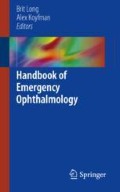Abstract
Several imaging modalities exist for ocular diseases and traumatic injuries. CT orbit is the preferred imaging modality in trauma. CT is insensitive for diagnosing open globe. If the history or physical examination suggests open globe but imaging is negative, the patient may still need surgical exploration due to the poor sensitivity of the test. In cases of suspected IOFB, CT scanning of orbits is the preferred and most sensitive modality. MRI should not be performed unless metallic IOFB has been ruled out. If suspicion for IOFB remains high despite negative CT scanning, MRI or US may be reasonable to evaluate for less common objects such as wood. The majority of medical conditions do not require advanced imaging. When advanced imaging is required, MRI with contrast provides the greatest soft tissue detail; however, CT orbits with contrast are often an acceptable choice. When evaluating for post-septal cellulitis, MRI orbits with contrast and CT orbits with contrast are both adequate imaging choices. Consider MRI in the pediatric population to limit radiation exposure. Physical exam can rule out post-septal cellulitis in many cases; when the diagnosis is unclear, imaging is indicated. The diagnosis of optic neuritis can be made clinically. Atypical presentations may warrant imaging for other possible causes. MRI brain and orbits with contrast can confirm the diagnosis or demonstrate alternative diagnosis.
Access this chapter
Tax calculation will be finalised at checkout
Purchases are for personal use only
References
Kubal WS. Imaging of orbital trauma. Radiographics. 2008;28(6):1729–39. https://doi.org/10.1148/rg.286085523.
Sung EK, Nadgir RN, Fujita A, et al. Injuries of the globe: what can the radiologist offer? Radiographics. 2014;34(3):764–76. https://doi.org/10.1148/rg.343135120.
Yuan WH, Hsu HC, Cheng HC, et al. CT of globe rupture: analysis and frequency of findings. Am J Roentgenol. 2014;202(5):1100–7. https://doi.org/10.2214/AJR.13.11010.
Joseph DP, Pieramici DJ, Beauchamp NJ. Computed tomography in the diagnosis and prognosis of open-globe injuries. Ophthalmology. 2000;107:1899–906.
Arey ML, Mootha VV, Whittemore AR, Chason DP, Blomquist PH. Computed tomography in the diagnosis of occult open-globe injuries. Ophthalmology. 2007;114(8):1448–52. https://doi.org/10.1016/j.ophtha.2006.10.051.
Bray LC, Griffiths PG. The value of plain radiography in suspected intraocular foreign body. Eye. 1991;5:751–4.
Saeed a CL, Malone DE, Beatty S. Plain X-ray and computed tomography of the orbit in cases and suspected cases of intraocular foreign body. Eye (Lond). 2008;22(11):1373–7. https://doi.org/10.1038/sj.eye.6702876.
Gor DM, Kirsch CF, Leen J, Turbin R, Von Hagen S, et al. Am J Roentgenol. 2001;177(5):1199–203. doi: 0361–803X/01/1775–1199.
Nagae LM, Katowitz WR, Bilaniuk LT, Anninger WV, Pollock AN. Radiological detection of intraorbital wooden foreign bodies. Pediatr Emerg Care. 2011;27(9):895–6. https://doi.org/10.1097/PEC.0b013e31822d3df2.
Brady SM, McMann MA, Mazzoli RA, Bushley DM, Ainbinder DJ, Carroll RB. The diagnosis and management of orbital blowout fractures: update 2001. Am J Emerg Med. 2001;19(2):147–54. https://doi.org/10.1053/ajem.2001.21315.
Wippold II FJ, Cornelius RS, Berger KL, Broderick DF, Davis PC, Douglas AC, Germano IM, Hadley JA, McDermott MW, Mechtler LL, Smirniotopoulos JG, Waxman AD. ACR appropriateness criteria® orbits, vision and visual loss. 2012.
Tintinalli JE, Stapczynski JS, Ma OJ, Yealy DM, Meckler GD, Cline DM. Tintinalli’s emergency medicine a comprehensive study guide. New York: McGraw-Hill Education; 2016. p. 2128.
Howe L, Jones NS. Guidelines for the management of periorbital cellulitis/abscess. Clin Otolaryngol Allied Sci. 2004;29(6):725–8. https://doi.org/10.1111/j.1365-2273.2004.00889.x.
C a LB, Sakai O. Nontraumatic orbital conditions: diagnosis with CT and MR imaging in the emergent setting. Radiographics. 2008;28(6):1741–53. https://doi.org/10.1148/rg.286085515.
Lee S, Yen MT. Management of preseptal and orbital cellulitis. Saudi J Ophthalmol. 2011;25(1):21–9. https://doi.org/10.1016/j.sjopt.2010.10.004.
Rudloe TF, Harper MB, Prabhu SP, Rahbar R, VanderVeen D, Kimia AA. Acute periorbital infections: who needs emergent imaging? Pediatrics. 2010;125(4):e719–26. https://doi.org/10.1542/peds.2009-1709.
Starkey CR, Steele RW. Medical management of orbital cellulitis. Pediatr Infect Dis J. 2001;20(10):1002–5. http://www.ncbi.nlm.nih.gov/pubmed/11642617.
Osborne BJ, Volpe NJ. Optic neuritis and risk of MS: differential diagnosis and management. Cleve Clin J Med. 2009;76(3):181–90. https://doi.org/10.3949/ccjm.76a.07268.
Lee AG, Lin DJ, Kaufman M, Golnik KC, Vaphiades MS, Eggenberger E. Atypical features prompting neuroimaging in acute optic neuropathy in adults. Can J Ophthalmol. 2000;35(6):325–30. http://www.ncbi.nlm.nih.gov/pubmed/11091914. Accessed 17 Sept 2016.
Kupersmith MJ, Alban T, Zeiffer B, Lefton D. Contrast-enhanced MRI in acute optic neuritis: relationship to visual performance. Brain. 2002;125(Pt 4):812–22. https://doi.org/10.1093/brain/awf087.
Rocca MA, Hickman SJ, Bö L, et al. Imaging the optic nerve in multiple sclerosis. Mult Scler. 2005;11(5):537–41. https://doi.org/10.1191/1352458505ms1213oa.
Wilhelm H, Schabet M. Diagnostik und Therapie der Optikusneuritis. Dtsch Arztebl. 2015;112:616–26. https://doi.org/10.3238/arztebl.2015.0616.
Author information
Authors and Affiliations
Editor information
Editors and Affiliations
Rights and permissions
Copyright information
© 2018 Springer International Publishing AG, part of Springer Nature
About this chapter
Cite this chapter
Basel, P. (2018). Ocular Imaging. In: Long, B., Koyfman, A. (eds) Handbook of Emergency Ophthalmology. Springer, Cham. https://doi.org/10.1007/978-3-319-78945-3_15
Download citation
DOI: https://doi.org/10.1007/978-3-319-78945-3_15
Published:
Publisher Name: Springer, Cham
Print ISBN: 978-3-319-78944-6
Online ISBN: 978-3-319-78945-3
eBook Packages: MedicineMedicine (R0)

